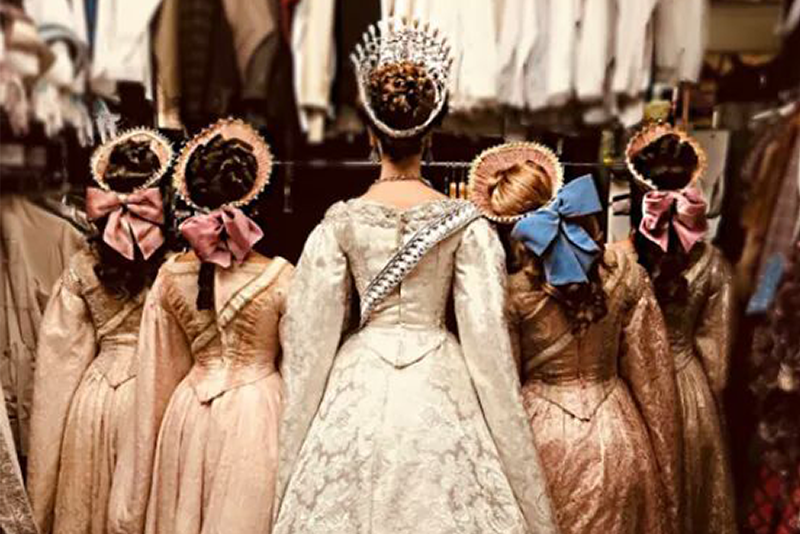
The holy Royal Martyrs are a bulwark, a firm wall of protection for the Russian people and land. Their icons adorn temples everywhere throughout Orthodox Russia and beyond, shining forth with the light of victory. Their people supplicate them, and they are quick to hear. Those who bore the crown are now borne as brilliant jewels on the crown of the Orthodox Church. The Moscow Patriarchate’s 2000 glorification of Tsar Nicholas II and his family—the Tsaritsa Alexandra, the Tsarevich Alexei, and the Grand Duchesses Olga, Tatiana, Maria and Anastasia— along with all the new martyrs and confessors of Russia was a necessary act of repentance from the preceding century, guiding the Church through its continuing resurgence, and one which led to the reunification of the mother Russian Church with its body abroad.
In this sense, in glorifying the Royal Martyrs the Church is simply following in the example that they had offered to us with their lives and in their holy deaths, humbly laying down their throne, and lives, in hopes of preserving the unity of the nation. In the words of Fr. Seraphim Rose, the Tsar was “the first Orthodox layman with a responsibility to give a Christian example to all his subjects,” and in honoring their earthly king the people were led to honor their Heavenly King. Christ also loved the church, and gave himself for it (Eph. 5:25), and in this image, as heaven’s representative on earth, the Tsar also went meekly to his fate as a faithful servant of Christ and of his people. The last Russian Tsar had been born on the day of the Church’s commemoration of the Prophet Job the Much-Suffering, and thereby through God’s providence sensed that his life would likewise know profound suffering—a suffering which he dutifully embraced: “Perhaps an expiatory sacrifice is needed for Russia’s salvation. I will be that sacrifice. May God’s will be done!”
While the memory, glory, and splendor of the noble Tsar and his immediate family are famed throughout the world, there are those amongst his extended family who can also capture our attention. While not a saint, also intriguing is the life of the Grand Duchess Olga Alexandrovna, the younger sister of Tsar Nicholas, memorialized in Ian Vorres’ The Last Grand Duchess (1965). The book was born out of a neighborly friendship: the Grand Duchess, spending her final twelve years in simplicity in Toronto, was wont to invite her neighbor, Ian Vorres, to tea. Vorres just happened to be a writer, and upon learning that his unassuming neighbor was in fact the last surviving Grand Duchess of the Russian royal house he convinced her to grant her blessing to capture her life in writing.

Told largely through her own words, the book offers an endearing picture of a girl, who although raised as the youngest child in one of the most powerful families on earth always cherished the traditional values, simplicity, and love of nature which her father, Tsar Alexander III, had instilled in her. She was especially close to her father, and was devastated when he unexpectedly died in 1894 when she was but twelve years old. She felt less close to her mother, Empress Marie Fedorovna, who expected her to take full part in the palace pageantry which was of little interest to Olga. Inspired by her desire for some measure of freedom from her mother she accepted the marriage proposal of her distant cousin Prince Peter of Oldenburg in 1901.
She soon regretted her hasty decision when in 1903 she met Colonel Nikolai Kulikovsky, the true love of her life. It was not until 1916 that her brother, Tsar Nicholas II, granted an annulment, and in the intervening years her marriage to Prince Peter remained unconsummated. During this time the Grand Duchess loved to paint and tend to the garden and she enjoyed an especially close relationship with her brother’s family. While her life, and the book The Last Grand Duchess, can stand on its own as a fascinating tale, Orthodox Christians can especially find much of note stemming from her closeness to the royal family—our Royal Martyrs. Although they have been officially glorified by both the Russian Church Abroad and the Moscow Patriarchate, many unfortunate rumors, lies, and slanders concerning their lives, their martyrdom, and the role of sacred monarchy continue to be perpetuated and sometimes deceive even our own Orthodox Christians.

Grand Duchess Olga was elated to marry Colonel Kulikovsky in 1916, but politics soon forced the happy couple to flee Russia to Denmark in 1919, and again to Canada in 1948 where they spent years tending to a farm, delighting in the simple life their situation afforded them, and becoming active and beloved members of the local Christ the Savior Cathedral. Vorres also writes of the Grand Duchess’ repose in a simple Toronto apartment on November 24, 1960, and, having been given a generous first-hand glimpse into Her Imperial Majesty’s life, the reader feels as if he has lost a friend. It is from these final years that the Grand Duchess vividly and often warmly recalled to her neighbor the events of her life, and she offers to the reader many invaluable first-hand accounts and analyses of the life and rule of her brother, Tsar Nicholas II, and his family, which stand in stark contrast to conventional “wisdom” concerning the Romanov dynasty.
Sacred Monarchy

Recalling how Russian troops responded to her father Tsar Alexander III, the Grand Duchess offers a beautiful statement of the Orthodox understanding of the anointed Emperor, which, as she notes, is beyond the comprehension of western religious and political systems:
It is all but forgotten today that to the Russian masses of my youth the Tsar was chosen by God to rule the country. Their devotion to him embraced their feelings for God and their country. Believe me, I have seen many examples of that truly dedicated affection. It was the main support of the Romanov sovereigns in their unrewarding task of wielding absolute power. Between the crown and the people was a relationship hardly ever understood in the West. That relationship had nothing to do with government or with petty officialdom. The Tsar and the people were bound together by the solemn vows of the Tsar’s coronation oath when he pledged himself to rule, judge, and serve his people. In a Tsar the people and the office were joined together.
This lofty statement should not be simply dismissed as from one biased by familial relations, as her words also adhere to the teachings of the God-bearing saints of the Church. Pondering why Tsar Nicholas II was maligned and finally martyred, St. John Maximovitch answered:
Because he was Tsar, Tsar by the Grace of God. He was the bearer and incarnation of the Orthodox world-view that the Tsar is the servant of God, the Anointed of God, and that to Him he must give an account for the people entrusted to him by destiny, for all his deeds and actions, not only those done personally, but also as Tsar … he was the bearer of the consciousness that the Supreme authority should be obedient to God, should receive sanctification and strength from Him to follow God’s commandments. He was a living incarnation of faith in the Divine Providence that works in the destinies of nations and peoples and directs Rulers faithful to God into good and useful actions. Therefore he was intolerable for the enemies of faith and for those who strive to place human reason and human faculties above everything.




